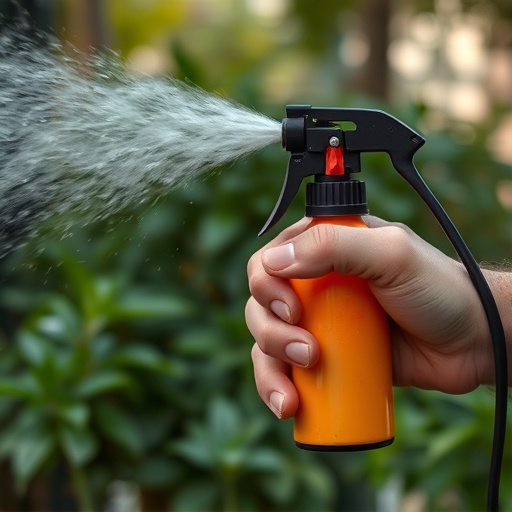Modern bear spray formulations remain effective against aggressive bears even in light rain due to active ingredients like capsaicin. Proper usage techniques, holding upright and aiming for the face, enhance its reach and duration. Selecting weather-resistant products with features like range and ease of use ensures optimal protection during outdoor activities in bear country.
“Staying safe during encounters with bears is crucial, especially in their habitat. This guide explores the power of bear spray as a defense mechanism, delving into its basics and effectiveness against these formidable creatures. We’ll dissect how pepper spray functions, particularly under varying weather conditions, like rain.
Additionally, we provide insights on selecting the right bear spray for your needs and offer vital safety tips for optimal use during attacks. By understanding these elements, you’ll be better equipped to navigate potential bear encounters with confidence.”
- Understanding Bear Spray Basics and Its Mechanism
- Pepper Spray Effectiveness in Different Weather Conditions
- Choosing the Right Bear Spray for Your Needs
- Safety Tips and Effective Use During Attacks
Understanding Bear Spray Basics and Its Mechanism
Bear spray, also known as pepper spray or capsaicin spray, is a non-lethal self-defense tool designed to deter and incapacitate aggressive animals, primarily bears. It works by targeting the animal’s sensory system, specifically its eyes, nose, and throat, which are highly sensitive areas. The active ingredient in bear spray is capsaicin, derived from chili peppers, which causes intense irritation and pain when it comes into contact with these mucous membranes.
In various outdoor scenarios, especially during hiking or camping in bear country, understanding how bear spray works under different conditions is crucial. For instance, the effectiveness of pepper spray in rain has been a topic of interest. While some studies suggest that water can reduce the spray’s potency, proper usage techniques and modern formulations have significantly enhanced its reliability as a defense mechanism. In fact, when used correctly, bear spray can be highly effective, even in rainy conditions, providing individuals with valuable time to escape or climb to safety.
Pepper Spray Effectiveness in Different Weather Conditions
Pepper spray, a popular self-defense tool against animal attacks, has proven its effectiveness in various settings. However, one common question arises when considering its performance in different weather conditions, particularly during rain. Surprisingly, pepper spray retains much of its potency even in moist environments like rain. The active ingredients in pepper spray are designed to disrupt the respiratory system of an attacker, and water does not significantly impair this action. In fact, some experts suggest that rain might even enhance the spray’s reach and duration since it can reduce visibility and slow down the attacker’s movements.
Despite the aforementioned effectiveness, it’s crucial to remember that pepper spray’s performance can be influenced by factors like wind and temperature. In heavy rain, the spray mist might spread more broadly, potentially reducing its concentration at close range. Yet, for everyday carry and outdoor activities, pepper spray remains a reliable defense mechanism against animal attacks, providing peace of mind in various weather conditions, including light rainfall.
Choosing the Right Bear Spray for Your Needs
When considering bear spray as a defensive measure, choosing the right product for your specific needs is paramount. Key factors include understanding the pepper spray’s effectiveness against both dry and moist conditions, such as rain. Some high-quality bear sprays are designed to maintain their potency even in wet environments, ensuring that you’re protected regardless of weather conditions.
Look for products with a proven track record of success, featuring ingredients like capsaicin or oleoresin capsicum (OC). These active ingredients deliver the pepper spray’s sting and can deter an attacking bear. Additionally, consider factors like range, wind resistance, and ease of use to maximize your safety during encounters in various outdoor settings, even when rain is a factor.
Safety Tips and Effective Use During Attacks
When using bear spray as a defense, it’s crucial to understand its effectiveness and proper usage. One common concern is its performance in rainy conditions, as water can reduce pepper spray’s intensity. However, many modern bear sprays are designed with improved weather resistance, maintaining their potency even in wet environments. To ensure safety during an attack, hold the canister upright, aiming for the bear’s face, and spray in short bursts. Keep moving to prevent continuous spraying, which could lead to inhalation issues. Practice using the spray beforehand, as proper technique is vital; it can be a game-changer when facing an aggressive animal.
Remember, bear spray is most effective as a deterrent and should be used as a last resort. Always stay alert in potential bear country, make noise to avoid surprising bears, and carry other safety equipment like whistles or lights. By combining these precautions with proper spray usage, you can minimize risks during outdoor adventures in areas known for bear populations.
Bear spray, a powerful defense against aggressive bears, has proven its effectiveness in various conditions. While pepper spray’s efficacy in rain is a common concern, studies show it can still deliver a strong punch, providing crucial seconds for escape. Choosing the right bear spray and learning safety tips are essential to ensuring its effectiveness during encounters. Always remember, prevention is key, but being prepared with the right knowledge and tools, like bear spray, can significantly enhance your safety in bear country.
